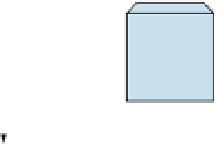Biomedical Engineering Reference
In-Depth Information
model the transformation of T4 into T3. Input to the system is through the plasma in either
compartment
q
5
.
Consider the movement of a drug in the body with the pharmacokinetic model in
Figure 7.10. After ingestion, the drug moves into the blood, where it is distributed in the
plasma. Drug distribution in the plasma is among water and proteins. Since drugs are rela-
tively small molecules, they easily move through the capillaries and into most fluids and
organs of the body. In addition, drugs move easily into the intracellular fluids of body tissues.
Each arrow in Figure 7.10 needs to be defined with a transfer rate. Obtaining values for the
transfer rates is usually very difficult or even impossible.
q
2
or
EXAMPLE PROBLEM 7.18
Consider the model
14
illustrated in Figure 7.33 for the oral input of the thyroid hormone
replacement therapy in which the body does not produce any thyroid hormone. While the model
is appropriate for either T3 or T4, here we track T3 and ignore T4 for simplicity. Assume T3 exists
in compartment 1 (gut) in solid form and in compartment 2 (still the gut) in liquid form. Compart-
ment 3 represents the plasma, and compartments 4 and 5 are the slow and fast tissues, respec-
tively. Assume that the input is bolus,
f
1
(
)
¼
25d(
), and that the initial conditions are zero.
t
t
Further,
K
12
¼
1.1,
K
20
¼
0.01,
K
23
¼
0.9,
K
34
¼
15,
K
43
¼
30,
K
40
¼
1.0,
K
35
¼
0.5,
K
53
¼
0.4,
and
K
50
¼
0.05. Note that
K
40
and
K
50
represent T3 metabolism. Solve for the quantity in compart-
ment 3.
Solution
The input is transformed into a new initial condition,
q
1
(0). The conservation of mass for each
compartment yields
q
1
¼
K
12
q
1
¼
1
:
1
q
1
ð
7
:
113
Þ
q
2
¼
K
12
q
1
K
20
þ
K
23
ð
Þ
q
2
¼
1
:
1
q
1
0
:
91
q
2
ð
7
:
114
Þ
q
3
¼
K
23
q
2
K
34
þ
K
35
ð
Þ
q
3
þ
K
43
q
4
þ
K
53
q
5
¼
0
:
9
q
2
15
:
5
q
3
þ
30
q
4
þ
0
:
4
q
5
ð
7
:
115
Þ
q
4
¼
K
34
q
3
K
40
þ
K
43
ð
Þ
q
4
¼
15
q
3
31
q
4
ð
7
:
116
Þ
q
5
¼
K
35
q
3
K
50
þ
K
53
ð
Þ
q
5
¼
0
:
5
q
3
0
:
45
q
5
ð
7
:
117
Þ
f
1
(t)
K
40
q
4
K
34
K
12
K
23
K
43
q
1
q
2
q
3
K
35
K
50
K
53
q
5
K
20
FIGURE 7.33
Illustration for Example Problem 7.18. Compartments 1 and 2 are the digestive system,
compartment 3 is the plasma, and compartments 4 and 5 are the fast and slow tissues, respectively.
14
See DiStefano and Mak, 1979, in references for original problem development.

























